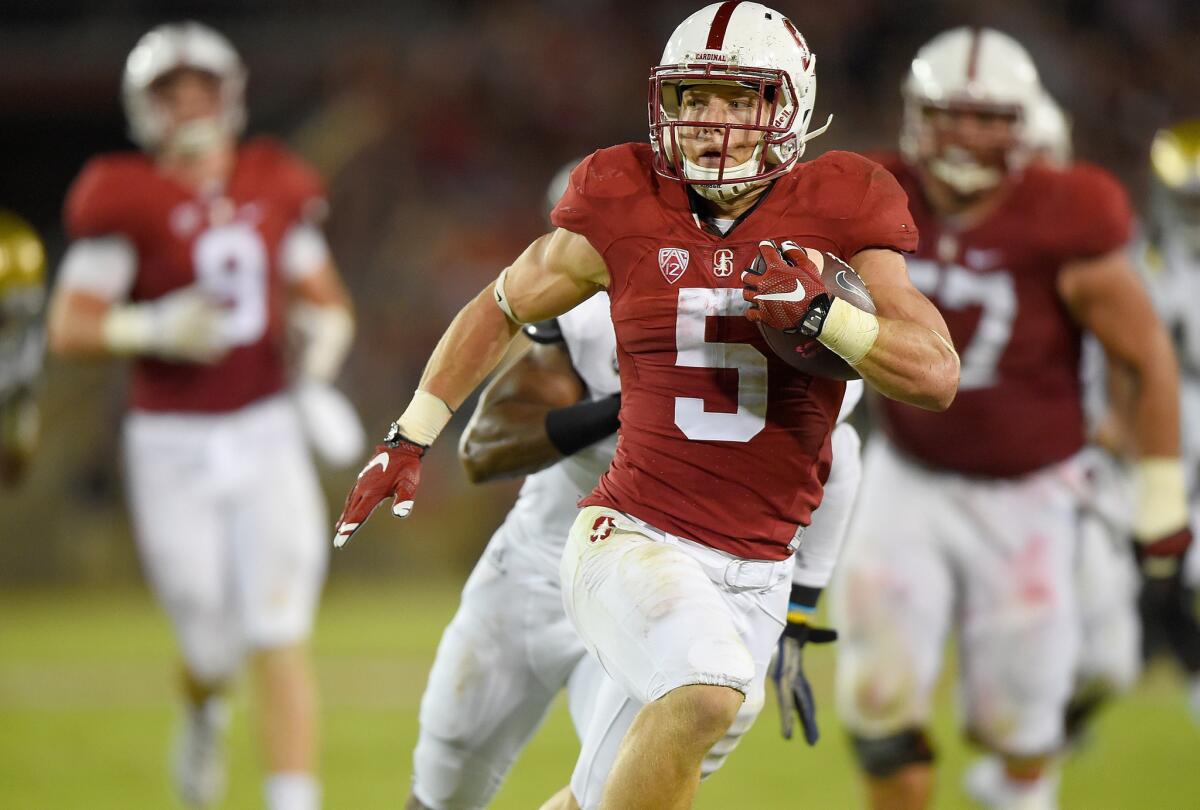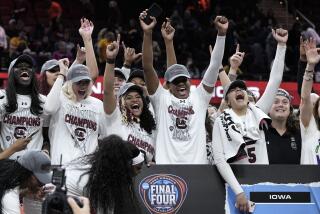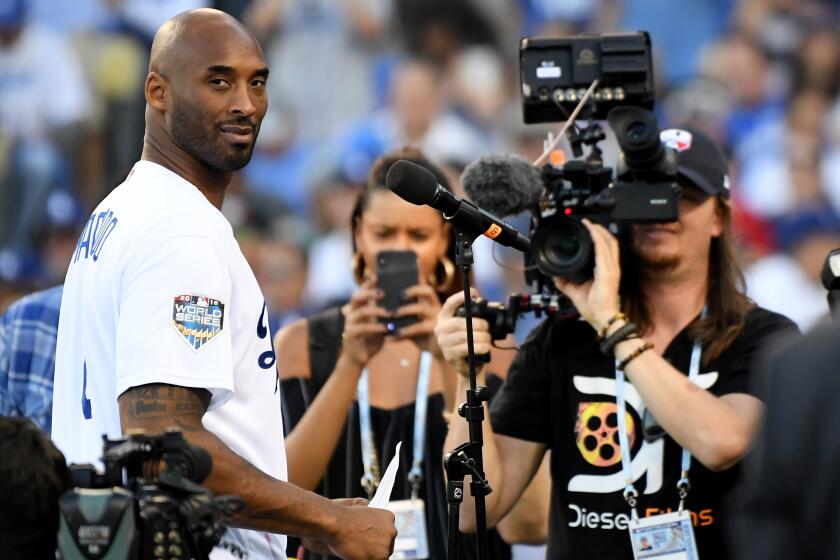How Stanford and Iowa match up for the Rose Bowl

Christian McCaffrey breaks into the clear on a touchdown run against UCLA during a Pac-12 game on Oct. 15.
Times staff writer Mike DiGiovanna examines how Stanford and Iowa match up in advance of Friday’s Rose Bowl game in Pasadena:
Stanford run game vs. Iowa defense
Stanford employs a balanced pro-style offense that reminds Iowa players and coaches of the good Wisconsin teams they’ve played in recent years. Of course, it makes sense to run the ball when you have the most dynamic back in the country in sophomore Christian McCaffrey, who rushed for 1,847 yards and eight touchdowns, and an experienced line that averages 301 pounds and is anchored by Outland Trophy winner Joshua Garnett, a 6-foot-5, 321-pound left guard. The Cardinal ranks 19th in the nation with an average of 225.1 yards rushing a game, and short-yardage specialist Remound Wright, who has only 209 yards on the season but has scored 13 touchdowns, is one of the reasons Stanford ranks third in third-down efficiency (51%). The Hawkeyes are not pushovers. They rank 10th in rushing defense, giving up an average of 114.9 yards a game and have a strong linebacking corps led by Cole Fisher and Josey Jewell. “It’s going to start with our D-line,” Iowa safety Jordan Lomax said of stopping McCaffrey. “They’re going to have to penetrate the offensive line. Then it comes down to the linebackers and secondary filling the right alleys in support and making the tackle. It’s going to take all 11 guys doing their job to stop the run.”
Edge: Stanford
::
Stanford passing vs. Iowa secondary
The Cardinal has talented receivers in Devon Cajuste, Michael Rector and Bryce Love. Tight end Austin Hooper has 31 catches for 415 yards and six touchdowns, and McCaffrey has a team-leading 41 receptions for 540 yards and four scores. The Hawkeyes rank ninth in interceptions (18) and 10th in pass-efficiency defense (106.5) and have the nation’s top defensive back in Desmond King, a junior corner who is projected as a first-round pick if he enters the NFL draft. “He’s very physical — he’s not afraid to get up and press, and then he does a good job of sticking to the player downfield,” Stanford quarterback Kevin Hogan said of King, who has eight interceptions. “He’s someone they can count on to make a play in crunch time and in big-game situations.” So is Hogan, who completed 194 of 283 passes for 2,644 yards and 24 touchdowns and had one of his best games against Notre Dame, which stacked defenders near scrimmage to defend the run. The Irish held McCaffrey to 94 yards in 27 carries, but Hogan completed 17 of 21 passes for 269 yards and four touchdowns. “You have to try to contain McCaffrey,” Iowa Coach Kirk Ferentz said, “but if you load up too heavy, they’ve got other ways to hurt you.”
Edge: Stanford
::
Iowa run game vs. Stanford defense
The Hawkeyes have what Stanford defensive end Brennan Scarlett calls “one of the best, if not the best, offensive lines we’ve faced,” a unit that has cleared the way for backs Jordan Canzeri, LeShun Daniels and Akrum Wadley to combine for 2,048 yards and 27 touchdowns. “They’re not trying to disguise what they’re doing,” Scarlett said. “They’re coming straight at us, and they’re going to do what they do regardless. Anybody who’s watched them this season knows what’s coming.” As good as the backs are, it’s the line, led by center Austin Blythe and guard Jordan Walsh, both NFL prospects, that most impresses Cardinal defensive end Aziz Shittu. “They’re probably one of the best-coached teams we’ve seen on film, the way the line works so well together,” Shittu said. “They’re coming off the ball in unison, they stick to their blocks and move guys off the ball.” Quarterback C.J. Beathard is a running threat but was slowed late in the season by a groin injury.
Edge: Iowa
::
Iowa passing vs. Stanford defense
Like Hogan, Beathard, who completed 202 of 329 passes for 2,570 yards with 15 touchdowns and four interceptions, has been called a good “game manager” for his ability to make smart decisions, run the offense with more precision than flash, and limit mistakes. Stanford defensive back Ronnie Harris said the label “is a little bit disrespectful” to Beathard, who took over as starter this season. “He’s more elusive and a lot more athletic than people give him credit for,” Harris said. “I think he has a great arm. I’ve seen him make every throw and turn a bad play into a great play. I’ve seen him scramble and buy time for his receivers to get downfield. He’s taken his team to 12-1 and does exactly what he’s asked to do within the system.” Beathard’s favorite target is 6-1, 185-pound junior receiver Matt VandeBerg, who is fearless on over-the-middle routes and led the team with 61 catches for 639 yards. His biggest target is 6-4, 250-pound tight end Henry Krieger Coble (32 catches for 385 yards). Beathard, the grandson of former NFL executive Bobby Beathard, shouldn’t be bothered by bowl-game pressure. He had one of his best games in the Big Ten championship game against Michigan State, completing 18 of 26 passes for 216 yards.
Edge: Iowa
::
Special teams
Iowa’s Marshall Koehn might have a little more leg than Stanford’s Conrad Ukropina — Koehn kicked a 57-yard field goal as time expired to beat Pittsburgh on Sept. 19 — but Ukropina is a little more accurate, having converted 17 of 19 attempts, including a 45-yarder to beat Notre Dame. Koehn has made 15 of 19. King volunteered to return kickoffs and punts last spring and has upgraded the Hawkeyes in those areas. Iowa ranked in the top five in the Big Ten in kickoff (25.6 yards) and punt (12.7) returns. But McCaffrey, who racked up 461 all-purpose yards in the Pac-12 championship game against USC, ranked eighth nationally in kickoff returns with a 28.9-yard average. Stanford’s Alex Robinson averaged 42.9 yards a punt, and Iowa’s Dillon Kidd averaged 40.4 yards a punt.
Edge: Stanford
::
Coaching
A huge roar went up in Iowa’s Kinnick Stadium on Sept. 5 when, in the second quarter of the season opener against Illinois State, the Hawkeyes faked a field goal attempt. The play failed to net a first down, but the fans applauded the usually conservative Ferentz for his creativity. After another fake field goal attempt in the second game at Iowa State, Ferentz told reporters they were witnessing “the new Kirk.” Ferentz’s willingness to move away from his predictable nature helped the Hawkeyes go from 7-6 last season to the brink of the College Football Playoff. And Ferentz, in his 17th season, was named Eddie Robinson coach of the year. Stanford Coach David Shaw, a former wide receiver and assistant coach at the school, has guided the Cardinal to three Pac-12 titles and three Rose Bowl berths — Stanford beat Wisconsin in 2012 but lost to Michigan State in 2013 — in five years and has established himself as one of college football’s most innovative minds.
Edge: Even
::
Final score: Stanford 27, Iowa 20
More to Read
Go beyond the scoreboard
Get the latest on L.A.'s teams in the daily Sports Report newsletter.
You may occasionally receive promotional content from the Los Angeles Times.











